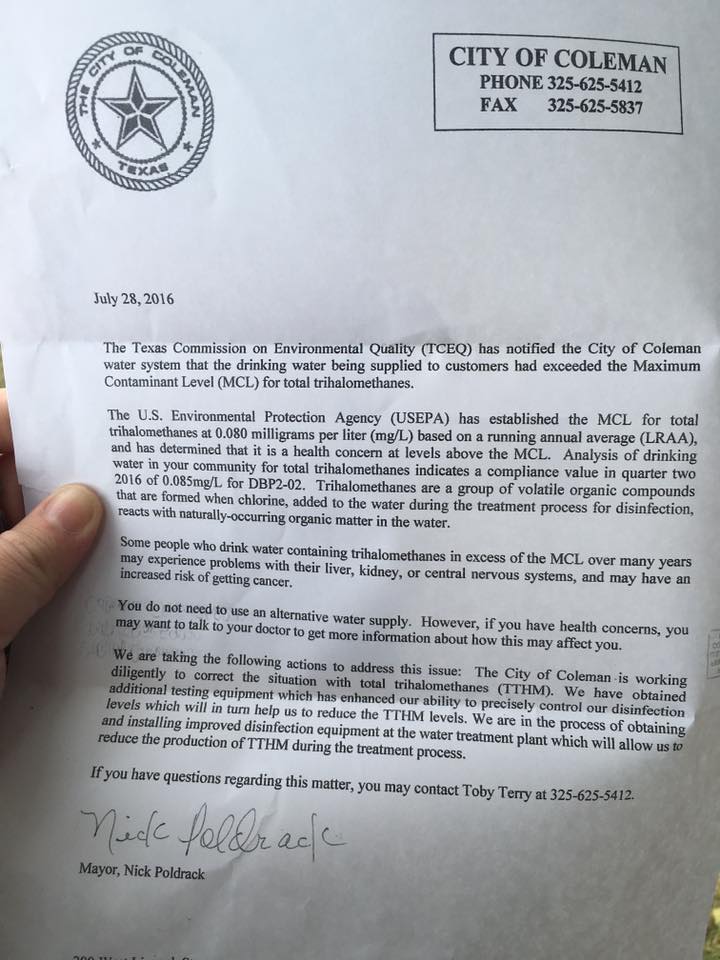SAN ANGELO, TX - The City of San Angelo is not the only town facing water issues and concerns. In fact, a few residents of Coleman and Junction had some lingering concerns over the summer in regards to notices they did or did not receive. Thus, to provide clarification, San Angelo LIVE! reached out to both towns to discuss these issues.
City of Coleman Addresses TCEQ Notice
On July 28, 2016, a letter went out to many Coleman residents that stated, "The Texas Commission of Environmental Quality (TCEQ) has notified the City of Coleman water system that the drinking water being supplied to customers had exceeded the Maximum Contaminant Level (MCL) for total trihalomethanes."
Trihalomethanes, according to the letter, are a group of volatile organic compounds that are formed when chlorine, added to the water during treatment process for disinfection, reacts with naturally-occurring organic matter in the water.
See the letter below:

Many people in the area complained that they didn't receive this letter despite the water concerns, and other residents claimed to suffer side effects from drinking the water, including Urinary Tract Infections.
In response, Water Supervisor Toby Terry explained the process that the City of Coleman has undergone to clarify what exactly happened with its water back in late July.
He discussed the burning process used to clean out the slime build up in the pipes from the distribution of water for the city, and he also explained how the process of using free chlorine has reduced the amount of trihalomethane (THMs) that is monitored quarterly by the TCEQ.
“The TCEQ requires that we run tests with chlorine disinfectant in our water supply on a quarterly basis,” Terry said. “Free chlorine has a quicker contact time, but dissipates faster, meaning it won’t reach the outskirts of the city’s water supply.”
He explained that on two of the four quarters, comprised of March, June, July, and December, the water reported a slight increase in THMs, which brought the 80 parts per billion average and raised it to 85 parts per billion.
“Basically, there were five extra drops in the billion drops of water of THMs, which is a miniscule amount,” Terry said.
The process for purifying drinking water uses total chlorine and monochloramines by applying liquid ammonia sulfate used for the distribution system. When the chemicals are mixed together over a six month period, the buildup of slime occurs in the distribution system.
The Center of Disease Control and Prevention defines chloramines as “[a] group of chemical compounds that contain chlorine and ammonia. The particular type of chloramine used in drinking water disinfection is called monochloramine.”
Free chlorine is the most efficient system used during the burn out process to clean out the slime, but because this can take six to seven days to finish, that chlorine was still in the Coleman water around the time the TCEQ ran the quarterly check for THMs, Terry said.
The U.S Environmental Protection Agency recorded the maximum contaminant level for THMs allowed in a water supply as 0.0080 milligrams per liter, based on the running annual average.
Terry mentioned that because of the spike in THMs, the City of Coleman had to inform the citizens of the increase and provide a public notice reading, “[Citizens] do not need to use an alternative water supply; however, if they have health concerns with their liver, kidney, or central nervous systems, to contact their doctors.” The letter also said continued exposure to this amount of THMs could cause cancer.
Terry said he explained the process to many citizens who called with concerns, and after explaining this information, they understood the burning process that happens with the distribution of water.
The TCEQ gives cities with this issue 30 days to inform the citizens of the change in the total THMs in the supply.
With the next quarterly test for THMs coming in late September, Terry believes the rating reported previously can be brought down to TCEQ requirements.
Junction Addresses Similar Concerns
Like City of Coleman citizens, residents in Junction claimed many did not know about the water concern notice issued in Kimble County. On Aug. 30, the Kimble County Chamber of Commerce & Junction Visitor Information posted the following notice to its Facebook Page:
"PLEASE - PLEASE citizens do not use water even if you have some available to prevent extending the time all citizens and businesses have access to water. The more you use before this issue is completely resolved and all tanks filled - issue will continue..."
In this case, citizens in Junction noticed a discoloration of their water, and recently, Mayor Russell Hammonds explained the events that led up to Junction having its water supply temporarily damaged.
“There were two separate incidents that started with the discoloration of the water,” Mayor Hammonds said.
He added that people had noticed the water had a yellowish hue that had been apparent after frequent rainfall. At first, they believed the coloring came from leafs that dropped into the water because of the rainfall that was rushing mud from the creeks downstream.
“The river turned extremely muddy,” Mayor Hammonds said. Because of this, it was decided that a boiled water notice would be put into effect for Junction.
This meant all water must had to be boiled before consumption.
TCEQ required that all accounts, like discoloring, be reported so an investigation could take place.
“TCEQ came out to test the water and realized there was no residual chlorine in it,” Mayor Hammonds said. “There always needs to be a little bit of chlorine left in the water so it can kill any bacteria that gets in there.”
Residual chlorine acts as a safeguard against the risk of contamination after any kind of water treatment. After receiving the water tests back on Aug. 25, the Boil Water Notice was put into effect the morning of Friday, August 26.
The second event occurred Saturday, Aug. 27, at around 8 p.m., when a thunderstorm hit Junction and caused the water plant to have an interruption in the power.
“The water tanks that hold our water went dry, and the machine was not able to turn back on to fill them back up,” Mayor Hammonds explained. “We are required by TCEQ, and our own operating procedures, that if there is a loss of pressure in the line, then [the City] must issue a boil water notice.”
The days following the storm had the plant's water tanks filled up again, and operations resumed as normal. The only exception was the faulty water board that caused the interruption; it had to be removed, and has since been operated manually. The water tests took place Sept. 2, and since then, residents no longer have to boil their water.
Subscribe to the LIVE! Daily
Required






Post a comment to this article here: